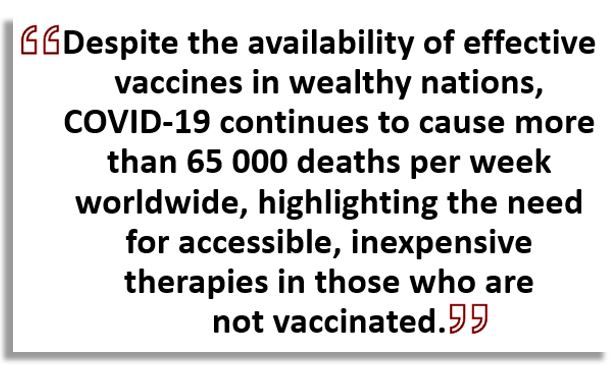Early Aspirin Use May Reduce Odds of In-hospital Death in COVID-19 Infection
In a cohort of more than 110 000 patients hospitalized with moderate disease, aspirin use on day 1 reduced odds of mortality by 15% and of PE by 29%.
Patients who received aspirin within the first day of hospitalization for COVID-19 infection had significantly lower odds of 28-day in-hospital mortality and pulmonary embolism compared with those who did not use aspirin, according to findings of an observational cohort study of >110 000 patients.

Study investigators, led by Jonathan Chow, MD, of the department of anesthesiology and critical care medicine, George Washington University School of Medicine and Health Sciences, found that the association between early aspirin use and reduced mortality risk was greater among older adults and those with ≥1 comorbidity and, importantly, that there was no significant difference in hemorrhagic events.
"Despite the availability of effective vaccines in wealthy nations,” wrote study authors in JAMA Network Open, “COVID-19 continues to cause more than 65 000 deaths per week worldwide, highlighting the need for accessible, inexpensive therapies in those who are not vaccinated.” They add the need is particuarly important in patients with moderate to severe disease.
As additional background for their current work the authors cite previous observational studies that suggest a mediating effect of aspirin on odds of COVID-19-associated inpatient mortality but note a range of limitations that leave substantial room for additional research.
Comprehensive data source
Chow and colleagues identified patients for their Analysis of National COVID-19 Hospitalization Outcomes in Recipients of Aspirin (ANCHOR) study using data from the National Institute of Health’s National COVID Cohort Collaborative (N3C) Data Enclave which contained data for nearly 8 million patients from 64 US health systems.
Patient enrollment began January 1, 2020, and the final data set of 2 446 850 patients with PCR-confirmed COVID-19 infection was completed on September 20, 2020. Of that set, 189 287 were hospitalized . After excluding patients aged <18 years and those who had severe disease on the first day of hospitalization, the final study cohort for analysis numbered 112 269 patients with moderate disease.
The full cohort had a median age of 63 years; 16.1% were African American, 3.8% Asian, 52.7% White, and 22.4% of unknown race and ethnicity.
A total of 15 272 patients (13.6%) were recorded as receiving aspirin on the day of hospital admission while 96 997 (86.4%) did not. In-hospital mortality occurred among 10.9% of the cohort.
Among those who received aspirin, median does was 81 mg and median treatment duration 5 days.
Early aspirin, no aspirin, in-hospital death
Before Chow and colleagues applied inverse probability of treatment weighting to reduce the probability of confounding, they report that rates of chronic kidney disease, chronic obstructive pulmonary disease, hypertension and diabetes were higher among aspirin group patients vs those who had not used aspirin. Prior aspirin use, they found, was higher in the aspirin vs no aspirin group (46.9% vs 4.2%, respectively).
In weighted analyses, receiving aspirin was associated with significantly lower odds of 28-day in-hospital mortality (10.2% vs 11.8%; OR, 0.85 [95% CI, 0.79-0.92]; P<.001). The investigators found that the rate of rate of pulmonary embolism, but not of deep vein thrombosis, was also significantly lower in patients who received early aspirin vs those who did not (1.0% vs 1.4%; OR, 0.71 [95% CI, 0.56-0.90]; P=.004).
When the researchers analyzed adverse events, particularly hemorrhagic events, they found no significant differences between early aspirin and no aspirin use groups in: gastrointestinal hemorrhage 0.8% aspirin vs 0.7% no aspirin; OR, 1.04 [95% CI, 0.82-1.33]; P=.72; cerebral hemorrhage 0.6% aspirin vs 0.4% no aspirin; OR, 1.32 [95% CI, 0.92-1.88]; P=.13; blood transfusion 2.7% aspirin vs 2.3% no aspirin; OR, 1.14 [95% CI, 0.99-1.32]; P=.06.
They also found an equal distribution of composite hemorrhagic complications between the 2 groups (3.7% aspirin vs 3.2% no aspirin; OR, 1.13 [95% CI, 1.00-1.28]; P=.054).
Subgroups: age, comorbidities
Analysis of prespecified subgroups found first, the association between early aspirin use and reduced mortality was higher in patients aged >60 years. The authors add those findings remained consistent after subgroup balancing and that odds were not lower among patients between ages 18 and 40 and between 41 and 60 who received early aspirin. Patients between ages 61 and 80 years and those older than age 80 had lower odds (p<.001 for both).
Second, and in a similar vein, in patients who did not have comorbidities, there was no association between early aspirin use and mortality (OR, 0.99; 95% CI, 0.80-1.23; P = .96), whereas in those with 1, 2, 3, and >3 comorbidities the odds of mortality were significantly reduced.
“This study suggests that early aspirin use may be associated with lower odds of in-hospital mortality among hospitalized patients with moderate COVID-19; these findings warrant further study in a randomized clinical trial that includes diverse patients with cardiovascular comorbidities,” investigators explained.
Reference: Chow JH, Rahnavard A, Gomberg-Maitland M, et al for the N3C Consortium and ANCHOR Investigators. Association of aspirin use with in-hospital mortality in patients with moderate COVID-19. JAMA Netw Open. 2022;5:e223890.